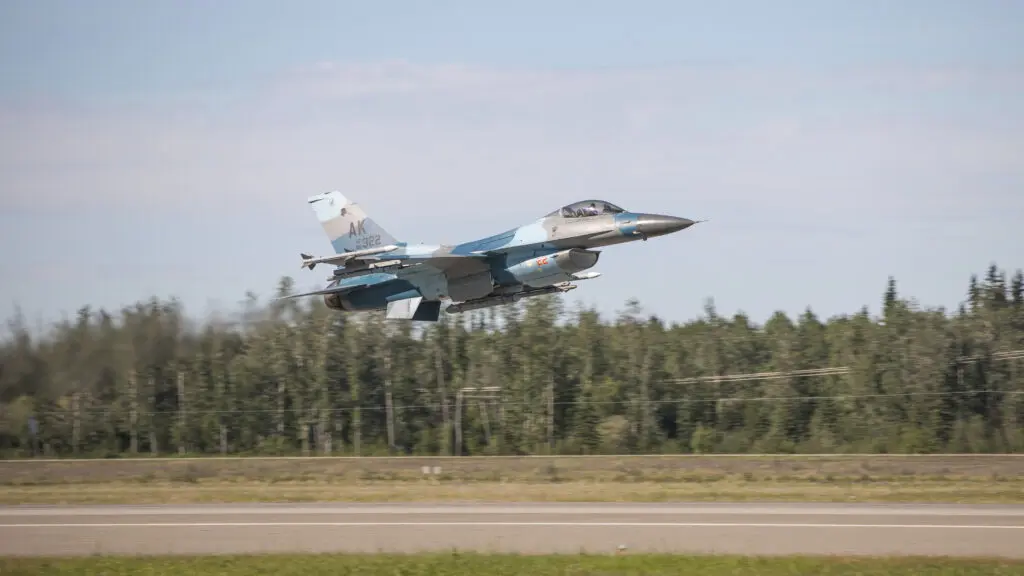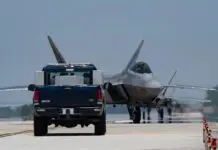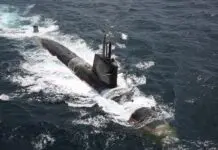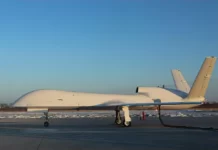In a recent incident within the Alaska Air Defense Identification Zone (ADIZ), U.S. Air Force F-16C fighters were deployed to intercept and escort two Russian Tu-95MS bombers from the Russian Aerospace Forces. This information was confirmed both by the North American Aerospace Defense Command (NORAD) and the Russian Ministry of Defense earlier this month. The event occurred when a formation of these aircraft, escorted by Su-30 and Su-35 fighters, conducted a long-range surveillance and exploration flight. Notably, the U.S. Fighting Falcon involved belongs to one of the previous aggressor units of the USAF, displaying its distinctive paint scheme during the flight.

According to NORAD’s official statement on May 2nd, a formation of Russian Aerospace Forces aircraft was detected in the Alaska Air Defense Identification Zone (ADIZ) on the same day. NORAD emphasized that the Russian aircraft formation never violated the sovereign airspace of Canada and the United States, limiting its surveillance and long-range exploration activities to international airspace.
The Russian Ministry of Defense stated, “Two Tu-95MS strategic bombers of the Russian Aerospace Forces conducted a scheduled flight in the airspace over neutral waters of the Bering Sea, near the western coast of Alaska. The flight lasted more than 11 hours. The crews of Su-30SM aircraft from the Aerospace Forces provided support to the fighters.”
While such incidents have occurred with varying frequency, as noted by NORAD in its official statement, it’s essential to highlight that the ADIZ should not be confused with sovereign airspace. As of today, the ADIZ can be understood as a zone unilaterally declared by any country to identify, locate, and control air traffic, civilian or military, in a specific region. Although widely employed by various countries worldwide, ADIZ are not governed or defined by any international treaty or convention.
In addition to NORAD’s report, the Russian Ministry of Defense recently released a video of the long-range exploration mission, showing strategic Tu-95MS bombers escorted by Su-35S and Su-30SM aircraft. Subsequently, an F-16C from the U.S. Air Force intercepts the formation, an incident not reported by NORAD in its May 2nd statement. The video depicts one of the Russian combat aircraft positioning itself behind the F-16C to monitor its movements.
An interesting aspect of this incident over the Alaska ADIZ is that the F-16C involved is one of the aircraft used by the USAF as part of its Aggressor Squadrons, specifically from the recently designated 18th Fighter Interceptor Squadron (formerly known as the 18th Aggressor Squadron). This squadron’s designation change signifies its new mission as one of NORAD’s primary aerospace defense assets, alongside F-22 Raptors, a change implemented in April at Eielson Air Force Base, Alaska. The decision to reassign the squadron was based on new U.S. national defense requirements in the region.
Returning to the events of May 2nd, the Russian Ministry of Defense’s video shows the F-16C maintaining its characteristic aggressor paint scheme, armed with two AIM-120D AMRAAM and AIM-9L/M Sidewinder BVR missiles, along with a Sniper targeting pod.



Additionally, the Russian fighter positioned behind the F-16C is a Su-35S armed with R-73A missiles. Although not shown in the video sequence, it is presumed that another F-16C from the 18th Aggressor Squadron was operating alongside the observed Fighting Falcon, as such missions are typically conducted in pairs, as seen in other regions globally, such as the Baltic.
*Cover photographs used for illustrative purposes.
You may also like: The US Air Force showcased the capabilities of its F-22 as part of the Agile Reaper Exercise in Alaska










